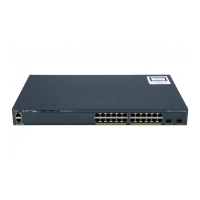PurposeCommand or Action
Specifies the IPv6 Source Guard policy name and enters IPv6
Source Guard policy configuration mode.
[no] ipv6 source-guard policy policy_name
Example:
Switch(config)# ipv6 source-guard policy
example_policy
Step 2
Defines the IPv6 Source Guard policy.[deny global-autoconf] [permit link-local] [default{.
. . }] [exit] [no{. . . }]
Step 3
• deny global-autoconf—Denies data traffic from
auto-configured global addresses. This is useful when all
Example:
Switch(config-sisf-sourceguard)# deny
global-autoconf
global addresses on a link are DHCP-assigned and the
administrator wants to block hosts with self-configured
addresses to send traffic.
• permit link-local—Allows all data traffic that is sourced
by a link-local address.
Exits to Privileged Exec mode.end
Example:
Switch(config-sisf-sourceguard)# end
Step 4
Shows the policy configuration and all the interfaces where the
policy is applied.
show ipv6 source-guard policy policy_name
Example:
Switch# show ipv6 source-guard policy
example_policy
Step 5
What to Do Next
Apply the IPv6 Source Guard policy to an interface.
How to Attach an IPv6 Source Guard Policy to an Interface
SUMMARY STEPS
1.
configure terminal
2.
interface Interface_type stack/module/port
3.
ipv6 source-guard attach-policy policy_name
4.
do show running-config
Catalyst 2960-XR Switch Security Configuration Guide, Cisco IOS Release 15.0(2)EX1
370 OL-29434-01
Configuring IPv6 First Hop Security
How to Attach an IPv6 Source Guard Policy to an Interface

